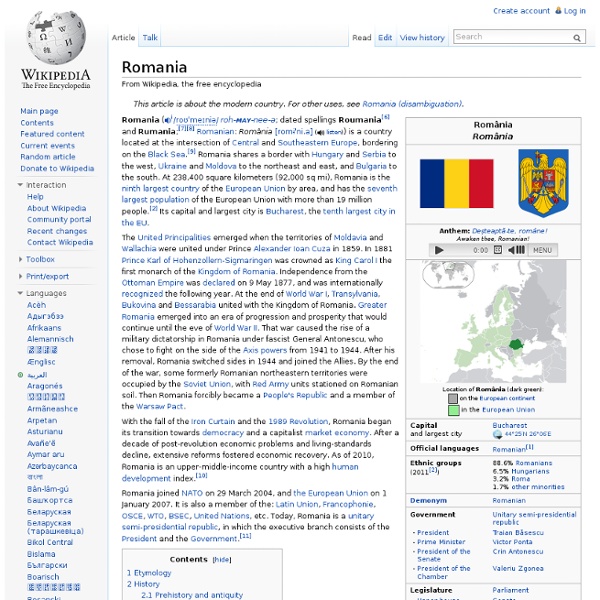Russia
Country spanning Europe and Asia Russia (Russian: Россия, Rossiya, [rɐˈsʲijə]), or the Russian Federation,[c] is a transcontinental country spanning Eastern Europe and Northern Asia. It is the largest country in the world, with its internationally recognised territory covering 17,098,246 square kilometres (6,601,670 sq mi), and encompassing one-eighth of Earth's inhabitable landmass. Russia extends across eleven time zones and shares land boundaries with fourteen countries. In 1991, the Russian SFSR emerged from the dissolution of the Soviet Union as the independent Russian Federation. Etymology History Early history The ancestors of Russians are among the Slavic tribes that separated from the Proto-Indo-Europeans, who appeared in the northeastern part of Europe c. 1500 years ago.[53] The East Slavs gradually settled western Russia in two waves: one moving from Kiev towards present-day Suzdal and Murom and another from Polotsk towards Novgorod and Rostov. Kievan Rus' Grand Duchy of Moscow
New Zealand
New Zealand (Māori: Aotearoa [aɔˈtɛaɾɔa]) is an island country in the southwestern Pacific Ocean. The country geographically comprises two main landmasses – that of the North Island, or Te Ika-a-Māui, and the South Island, or Te Waipounamu – and numerous smaller islands. New Zealand is situated some 1,500 kilometres (900 mi) east of Australia across the Tasman Sea and roughly 1,000 kilometres (600 mi) south of the Pacific island areas of New Caledonia, Fiji, and Tonga. Because of its remoteness, it was one of the last lands to be settled by humans. Polynesians settled New Zealand in 1250–1300 CE and developed a distinctive Māori culture. Nationally, legislative authority is vested in an elected, unicameral Parliament, while executive political power is exercised by the Cabinet, led by the Prime Minister, who is currently John Key. Etymology Detail from a 1657 map showing the western coastline of "Nova Zeelandia" History Politics Government Foreign relations and the military Environment Climate
Tokyo
Tokyo (東京, Tōkyō?, "Eastern Capital") (Japanese: [toːkʲoː], English /ˈtoʊki.oʊ/, listen ), officially Tokyo Metropolis (東京都, Tōkyō-to?) Tokyo is often referred to and thought of as a city, but is officially known as a "metropolitan prefecture", which differs from a city. The Michelin Guide has awarded Tokyo by far the most Michelin stars of any city in the world.[15][16] Etymology[edit] Tokyo was originally known as Edo, which means "estuary".[17] Its name was changed to Tokyo (Tōkyō: tō "east" and kyō "capital") when it became the imperial capital in 1868,[18] in line with the East Asian tradition of including the word capital ('京') in the name of the capital city.[17] During the early Meiji period, the city was also called "Tōkei", an alternative pronunciation for the same Chinese characters representing "Tokyo". The Edo-to-Tokyo renaming was first suggested in 1813 in the book Kondō Hisaku (ja) (Secret Plan of Commingling), written by Satō Nobuhiro. History[edit] 1869–1943[edit]
Madrid
Madrid (English /məˈdrɪd/, Spanish: [maˈðɾið]) is the capital of Spain and its largest city. The population of the city is roughly 3.3 million[4] and the entire population of the Madrid metropolitan area is calculated to be around 6.5 million. It is the third-largest city in the European Union, after London and Berlin, and its metropolitan area is the third-largest in the European Union after London and Paris.[5][6][7][8] The city spans a total of 604.3 km2 (233.3 sq mi).[9] Madrid houses the headquarters of the World Tourism Organization (WTO), belonging to the United Nations Organization (UN), the SEGIB, the Organization of Ibero-American States (OEI), and the Public Interest Oversight Board (PIOB). While Madrid possesses a modern infrastructure, it has preserved the look and feel of many of its historic neighbourhoods and streets. History[edit] Toponym[edit] There are several theories regarding the origin of the name "Madrid". Middle Ages[edit] Modern Age[edit]
Louvre
Pont-a-Mousson
Pont-à-Mousson (French pronunciation: [pɔ̃.ta.mu.sɔ̃]) is a commune in the Meurthe-et-Moselle department in north-eastern France. Population (1999): 14,592 (Mussipontains). It is an industrial town (mainly steel industry), situated on the Moselle River. Demographics[edit] History[edit] Early Modern[edit] In 1572 Cardinal Charles of Lorraine established a Jesuit university at Pont-à-Mousson. During the seventeenth century the university grew rapidly until there were about 2,000 students. 18th and 19th centuries[edit] The town continued to flourish as a centre of the visual arts, however, rivalling Épinal to the south in this respect. It was the regional capital between 1790 and 1795, but underwent extensive destruction in the ensuing wars, and was subject to foreign occupation in 1814 and 1815. 20th century[edit] People[edit] Pont-à-Mousson was the birthplace of: See also[edit] Communes of the Meurthe-et-Moselle department References[edit] External links[edit] Town's website
Yi Peng Festival
Close to the border of Myanmar and Laos, the name Chiang Mai means ‘New Town’ and is Thailand’s second largest city and an important region for eco-tourism. As the capital of northern Thailand, Chiang Mai serves as an excellent base for exploring the northern region and for going on excursions in the lush hinterlands. Visitors often head to Chiang Mai to sample local cuisine, see one of the many beautiful temples or go on a hill tribe trek to observe how traditional ways of life are preserved. As one of the country’s prime tourist destinations, it is a city of outstanding natural beauty, with cool mountain climate and a rich cultural and historical heritage. Chiang Mai’s attractions include Wat Phrathat Doi Suthep, Chiang Mai City Arts & Cultural Center and the Elephant Nature Park. Google +



